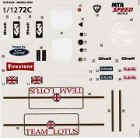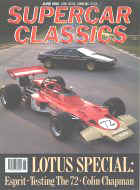|
When Mr. Colin Chapman presented the new Lotus 72, he was setting the foundations for the evolution of Formula 1 racing cars. The contributions made by this car, in terms of technical innovations, where very important for this period. At first sight, the first thing that comes to our eyes, is the location of the radiators on both sides of the body, these change alone, had a very important influence in the aerodynamic design and the weight distribution; moving the front disc brakes inside the body, the relocation of the fuel tank, and the new geometry for the rear wing, created a new landmark in Formula 1 design.
|
I will explain here, my development plan for this model. I have good reference pictures that I've followed for the detailing and the modifications. I must say that although this is my working plan, you can follow it or you can make other changes depending on the model year, the driver, etc...
|

|
|
Materials
All the changes are made on an original Tamiya Lotus 72 D kit; we will use almost 90% of the original parts. The most important changes are: painting, decals, some modifications to the body and oil refrigeration system. For our project, we will need the following extra items:
|

|
 Gold Leaf decal sheet, MTR Decals has a complete sheet for a Lotus 72 A. Gold Leaf decal sheet, MTR Decals has a complete sheet for a Lotus 72 A.
 Styrene sheet 0,2 mm. Styrene sheet 0,2 mm.
 Vinyl tubing in different diameters. Vinyl tubing in different diameters.
 Wire in different sizes. Wire in different sizes.
 Modeler's mesh hose. Modeler's mesh hose.
 Modelers Hose Joint set. Modelers Hose Joint set.
 Car body colors: Car body colors:
 Red (X7) Red (X7)
 White (X2) White (X2)
 Gold Leaf (X12) Gold Leaf (X12)
 Alclad II metallic paints. Alclad II metallic paints.
 Tools and other common materials. Tools and other common materials.
The conversion
I have followed the instruction manual sequence, which is:
Step one, rear wing building, the first Lotus 72 versions, and specially the one driven by Jochen Rindt, used a rear wing comprised of three independent regulating small wings. If we decide to depict this type of spoiler, we must build it from scratch. There was another option which appeared after this one, mounting the rear spoiler that comes in Tamiya's Lotus 72 D kit; the pictures that I have show that rear wing model, so I decided to use the one that comes in the kit.
Step two, mounting the front cowling, here we will have to drill a hole for the disc brake cooling air duct. The Lotus 72 A had non air ventilated disc brakes; follow the drawing to see where to drill the holes, all measurements are in mm.
Steps three and four, there is nothing to be changed in these steps because the Lotus 72A didn't have an oil tank, nor an induction pod, so we will have to scratch build these parts. I am sorry I don't have any drawings available showing how to do it, but I have some pictures that I will gladly provide, if you ask for them.
For the induction pod you can consult the one in the Lotus 78 because they are very similar, I promise that as soon as I have the drawings, I will send them to Modeler Site, so you can find them there.
If you think that the construction of the induction pod is very tricky, don't worry, the first Lotus 72A did not have this part. Steps 11 and 12, all the parts to painted in gloss black, will be polished aluminum. In step 15, the holders for the disc brakes (G13 & G14), must be painted polished aluminum. We will have to change them to non ventilated brake discs, or blockup the ventilation groove. I have decided to build the engine as supplied in the kit, without modifications. The body color scheme is without any doubt the big difference between this two models, in order to apply this color scheme, I referred to the pictures that I have, and to the Lotus 49B.
|
Conclusion
If you can get MTR decal sheet will be a big advantage for you, if not, you can always do them by yourself with PC and printer. Well, how I said at the beginning this is my transformation plan, for sure will be someone who think that is a poor one, but this is what my knowledge and skills enable me. Presently I have started assembly and looking forward to communicate you in the next time how to do it steep by steep. Enjoy!.
Reference Here the reference I have used. The June 1990 Supercar Classics mag.
|

|
|